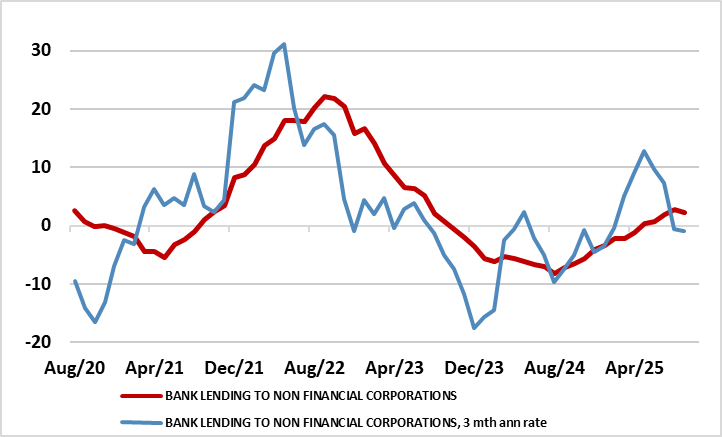Sweden Riksbank Review: Board Sticks to it Plans
As we anticipated in our preview, the Riksbank Board is pleased with the data flow since its last and very probably final rate cut on Sep 23 (to 1.75%). GDP indicators suggest a strong Q3 showing of over 1% q/q while previously troublesome CPI data have softened appreciably thereby confirming (both our and Board) suspicions that the prior spike was aberrant. Admittedly, that GDP pick-up may be aberrant too, not least given the still gloomy message from the Riksbank’s own business survey and what are still soft labor market and monetary numbers (Figure 2). Thus the existing Board promise of no change was adhered to this time around, with the lack of any scheduled updated projections making the policy outlook beyond still uncertain. Regardless, we do not see any looming policy reversal, as we see this current policy rate (1.75%) staying in place through 2027, ie a little longer than the Riksbank (Figure 1).
Figure 1: Riksbank Policy Rate Outlook

Source; Riksbank Monetary Policy Report (MPR)
Indeed, it now seems all the clearer that the CPI spike seen in the July data was aberrant even though it partly persisted into August – flash October data (Nov 6) may show a very decisive drop for targeted CPIF inflation to a 5-6 moth low of around 2.6%. Indeed, that spike was almost certainly a reflection of temporary factors, most notably energy price swings, alongside what may be a more sustained but far from demand-driven recent tripling in food inflation. To us, the underlying picture is reassuring as seen in the ex-energy CPIF measures is still consistent with target and this is despite the impact on this measure of food inflation, albeit where the latter has slowed from running at over 5% to just over 3% (still something more supply driven and also likely to weigh on spending power). Indeed, the Board view still suggests that ‘several indicators support the view that inflation will fall back to target going forward’. Notably the updated Riksbank CPIF forecast shows inflation well above target through 2028 but this is a result of VAT tax swing induced base effects that anything underlying.
But the real economy backdrop is still puzzling. Despite an apparent 1%-plus q/q Q3 GDP jump (twice Riksbank thinking), the economy still looks soggy, not least in the labor market. But the Riksbank will note the results if its own survey, which underscores that Swedish companies describe the economic situation as a long and protracted slump that has not improved since the spring and where industrial activity has weakened. In particular, the survey stresses that high unemployment is also weighing on expectations and is described as “the biggest challenge”. In addition, many respondents wonder whether households will continue to be cautious about consumption for a longer period. As a result, the subdued mood is reflected in the Business Survey indicator, which summarises the Riksbank’s Survey’s results. The indicator has weakened since May and remains below its historical average, as it has done since the end of 2022.
Figure 2: Fresh Company Lending Weakness Emerging?

Source; Riksbank
Thus we are more sceptical than the Riksbank regarding whether an early-stage recovery is emerging or not. However, the overall policy mix is set to turn markedly more accommodative as fiscal stimulus from the budget bill takes effect into the election year of 2026. Against this backdrop, we see little reason for more monetary action – even as inflation temporarily dips below target due to the halving of food VAT in April 2026, which should have an immediate impact in slashing over 0.5 ppt off all main inflation measures; unemployment remains elevated and what may be a fresh weakening in monetary data (Figure 2). At the same time, these same two factors should also keep the Riksbank from considering hikes in the near term. But as the two-way risks profile the Board present; the jury is out – still!
I,Andrew Wroblewski, the Senior Economist Western Europe declare that the views expressed herein are mine and are clear, fair and not misleading at the time of publication. They have not been influenced by any relationship, either a personal relationship of mine or a relationship of the firm, to any entity described or referred to herein nor to any client of Continuum Economics nor has any inducement been received in relation to those views. I further declare that in the preparation and publication of this report I have at all times followed all relevant Continuum Economics compliance protocols including those reasonably seeking to prevent the receipt or misuse of material non-public information.